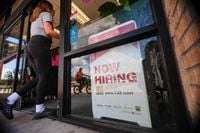On Tuesday, October 1, 2025, the U.S. government began a significant transition in how it delivers benefits, phasing out paper checks for most federal programs. This move, set in motion by an executive order signed by President Donald Trump in March, is intended to modernize government payments and collections by shifting to electronic methods. The administration argues that this change will protect taxpayers from fraud and stolen checks, speed up payment processing, and reduce costs. However, the new policy has sparked concern among advocates for low-income Americans, who warn that the shift may leave the most marginalized behind.
According to the Associated Press, the phase-out directly affects recipients of Social Security, Supplemental Security Income (SSI), and tax refunds. Instead of receiving paper checks, beneficiaries will now get their payments through direct deposit or a Direct Express card, a prepaid debit card designed for people without a bank account. The Social Security Administration (SSA) has emphasized that it will continue to issue paper checks only if no other payment options are available. Still, for many, this assurance does little to quell anxiety about potential disruptions.
Jennifer Burdick, a divisional supervising attorney in the SSI Unit at Community Legal Services in Philadelphia, explained, “A lot of claimants move around and don’t always get their mail. And the folks that I represent who get paper checks mostly learned from me about this transition.” Burdick noted that roughly 10% of her clients still receive paper checks, and she worries that new recipients who need a paper check to open a checking account may find it nearly impossible after the phase-out.
The numbers, while seemingly small in percentage terms, are still significant in absolute terms. Nearly 400,000 Social Security and SSI recipients currently receive their benefits through paper checks—a figure that represents less than 1% of the 70.6 million retirees, disabled people, and children who depend on these programs. Yet as Kathleen Romig, director of Social Security and disability policy at the Center on Budget and Policy Priorities, pointed out, those most affected by the change are often the most vulnerable. “Often unbanked or unhoused, and lacking in the tools and skills they need to access digital services,” Romig said. “This is a population that can’t afford to miss a payment, so it’s very important that the Trump administration manage the transition without interrupting their benefits.”
Some individuals have avoided electronic payments for a host of reasons: mental health crises that make them wary of financial institutions, a lack of funds to open a bank account, or simply not having the necessary documentation. Nancy Altman, president of Social Security Works, an advocacy group, called the phase-out unnecessary and potentially harmful. “If it’s not handled right, it will be devastating for people who are unaware of the change and have limited incomes,” Altman said. “I think anyone should be able to get a paper check. And while less than 1% is getting a check, that’s still a lot of people.”
While the government’s stated aim is to streamline operations and reduce fraud, the real-world impact on marginalized communities remains to be seen. The SSA maintains that exceptions will be made for those who truly have no other means, but advocates remain skeptical about whether this safety net will be robust enough in practice. The transition comes at a time when the broader U.S. economy is also facing significant headwinds, raising further questions about the timing and implementation of such a sweeping change.
On the same day as the paper check phase-out, the Labor Department released its latest Job Openings and Labor Turnover Survey (JOLTS), providing a snapshot of a job market that appears to be losing steam. According to the Associated Press, U.S. job openings in August 2025 were essentially unchanged at 7.23 million, a slight uptick from 7.21 million in July. This figure defied economists’ expectations, who had forecast a drop to 7.1 million. Despite this, the overall trend is one of decline: job openings have fallen steadily since peaking at a record 12.1 million in March 2022, when the economy was roaring back from COVID-19 lockdowns.
Layoffs actually fell in August, but so did the number of people quitting their jobs—a sign that workers are less confident about finding better opportunities elsewhere. The hiring rate in August was the weakest since June 2024, reflecting growing caution among employers. “Companies are clearly hoarding workers with the economy still at full employment,” observed Carl Weinberg, chief economist at High Frequency Economics, in a commentary quoted by the Associated Press. “It will take a bigger blow than what we have seen so far to convince companies that it is safe and prudent—and necessary—to lay off workers.”
Despite these challenges, the unemployment rate remained low at 4.3% as of late September 2025. However, jobseekers are finding it increasingly difficult to land new positions. The Labor Department recently revised its data, revealing that 911,000 fewer jobs were created in the year ending March 2025 than initially reported. This means that employers added an average of fewer than 71,000 new jobs per month during that period—far below the 147,000 originally estimated. Since March, job creation has slowed even further, averaging just 53,000 new jobs per month.
Several factors are contributing to this cooling labor market. The lingering effects of 11 interest rate hikes by the Federal Reserve in 2022 and 2023 have dampened economic activity, making businesses more cautious about expanding their payrolls. Uncertainty stemming from President Trump’s trade policies and the threat of a government shutdown have also played a role, leaving managers hesitant to make hiring decisions. The Labor Department is expected to release September hiring and unemployment numbers on Friday, October 3, though a budget impasse in Congress could delay the report.
In response to these economic signals, Federal Reserve policymakers cut their benchmark interest rates for the first time in 2025 two weeks ago, aiming to support the sputtering job market. They have also signaled that two more rate cuts could be on the horizon before the end of the year.
The confluence of these policy changes—both in how Americans receive their benefits and in how the job market is evolving—highlights the precarious position of many U.S. households. For those already struggling to make ends meet, missing a payment or losing a job can have outsized consequences. As the government moves forward with its digital transformation, the challenge will be to ensure that no one falls through the cracks, especially as economic uncertainty clouds the outlook for workers and retirees alike.
As the dust settles from Tuesday’s twin developments, the stakes could not be higher for millions of Americans. Whether the transition to electronic payments delivers on its promise of efficiency without sacrificing access, and whether the job market can regain its lost momentum, will depend on the careful management of both policy and people in the months ahead.




